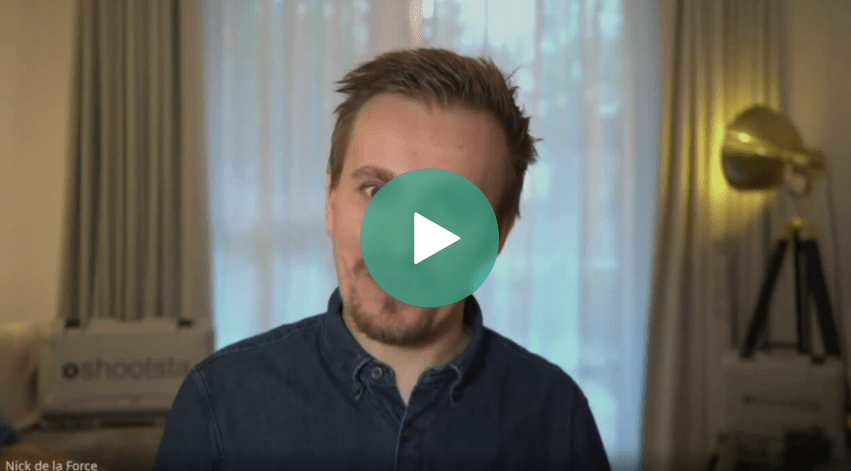When it comes to content, ‘storytelling’ is the buzzword of the decade. And in digital, expectations for video storytelling are high, thanks to its legacy association with film and television (Pixar’s first creative principle? ‘Story is king’). The problem is, the way audiences consume content online has changed, particularly with advances in mobile technology – which has implications for the way we craft visual stories, especially in the business world. So the question is: how do we move from traditional conventions into this brave new world of video content? How do we win at video storytelling?
Start with why
Effective video storytelling begins with knowing why your content needs to exist. Your video must serve a purpose for your audience, as well as obviously meet business and content goals by communicating your key message and prompting behaviour with a call-to-action (CTA). To nail your why, consider the following:
Target audience
Who are you trying to communicate with?
If you’re in marketing, buyer personas will help define not only audience demographics, but also psychographics like interests, values and attitudes, which all inform behaviour. Target your audience by creating videos that address their challenges, such as ‘help’ content like (searchable) frequently asked questions.
Not a marketer, but still interested in personas? HubSpot has a great downloadable persona template, available here.
Objective
What are your business and content goals?
No matter whether you’re in marketing, internal communications, learning and development, human resources or sales, video is used to communicate information. So if your business (or function) goal is to ‘grow by achieving X in sales’, then a video discount offer at the bottom of the funnel might have a content goal of website conversions e.g. to an e-commerce product page.
Message
How should you position your message to resonate with your audience?
Your message should be informed by your audience and objective. For example, internal communications and HR professionals often need compliance-based videos that check policy boxes. If so, reducing the barrier to entry by respecting people’s time and leading with your most salient point, then presenting your arguments to define the challenge and how the business will solve it (within the context of what people care about) works wonders.
Creating desire in the audience and then showing how your ideas fill that desire moves people to adopt your perspective.” — Nancy Duarte, Resonate
Call-to-action
What action must be completed to achieve your objective?
How do you want people to feel after watching your video, and what should this emotion inspire and motivate them to do? Again, think back to your objective. If your content goal is brand awareness, you might simply invite viewers to like, comment or share your video, which aids reach and recall.
Forget everything you know about story arcs
Run a quick Google search on ‘storytelling’ or ‘video storytelling’, and you’ll find people still reference Syd Field’s three-act story structure (with a hefty dose of conflict to move the plot along). As we mentioned earlier, the problem is, audiences don’t consume content the way they used to. Videos on social, for example, aren’t film or TV – in this new era of the ‘attention economy’, disengaging videos are stoppable and skippable. So if your video isn’t delivering value in a timely manner, you may need to rethink the way you’re creating content.
Rethinking video is exactly what Google / YouTube’s ‘Unskippable Labs’ team were tasked with, and what they found was this: “the traditional build-up-climax-payoff is a thing of the past, even if advertising creatives are still learning to relax the muscle memory it’s instilled”. Instead, “the successful story arc that’s emerged today starts with fire, moves fast and tightly over its subjects, then adds unexpected surprises along the way – should a viewer choose to keep watching amidst her abundance of choice”. The way they summarised this new paradigm? The ‘heartbeat’, versus the traditional ‘hill’ (three-act, bell curve etc.) arc of old.
Traditional story arc
(a.k.a. the ‘hill’)
Emerging story arc
(a.k.a. the ‘heartbeat’)
You’ll be familiar with the traditional story arc’s structure:
-
t
- The lead in
- Building to the turning point
- The climax, followed by the big reveal
- The marketing / sales offer
- Branding e.g. logo
t
t
t
t
The emerging story arc, however, capitalises on serving value upfront, in order to instantly capture and sustain viewer attention:
-
t
- Start high by front-loading your story arc
→ Example: lead with your message - Subtle brand cues
- Unexpected shifts and surprises for audience pick-me-ups
- Multiple peaks to facilitate movement
- Further content for those who want it e.g. sequential videos
t
t
t
t
Being Google, the Unskippable team ended their emerging story arc with a point on search intent and user signals, for storytelling that’s not just emerging but constantly evolving: “Focus on what gets skipped and what doesn’t. Knowing what a viewer connects with is a valuable tool to inform your next piece of creative”.
For more on signals and measuring video success (i.e. the ‘waterfall method’, not dissimilar to Google’s ‘heartbeat’), check out our video.
The 3-10-30 rule
At Shootsta, we’re champions of the 3-10-30 rule: grabbing attention in the first 3 seconds, setting the scene in the first 10 seconds, and communicating your message in the first 30 seconds. After the 30-second mark, it’s all about keeping attention by adding new information, then ending and extending with your call to action (and being us, we made a video about it – watch it below!).
The art and science of visual storytelling
Finally, we thought we’d close with best practices for great creative from one of video’s biggest fans (since, well, Google / YouTube) – Facebook:
-
t
- Create ‘thumb-stopping’ content
-
t
- Facebook wants its creative to stop thumbs and move hearts, because “if mobile moves people, it’ll move business”. To that end, they recommend “consider[ing] creative characteristics – like visual cues and brand links – and how they work together to effectively deliver messages” for video.
- FYI, Google backs this, saying that leveraging visual language with tight framing, fast pacing, high contrast (e.g. colours) and unmissable supers (read: text) makes videos more distinctive.
t
- Think mobile-first
-
t
- Ideally, with vertical (4:5 or 9:16) or square (1:1) videos. The rationale? “Most people hold their phones vertically so choose a vertical or square aspect ratio to cover the most screen area”.
- Also – prioritise a duration of 15 seconds or less. Content examples include product discovery and product benefit videos.
t
- Get personal
-
t
- Attention is all about relevancy. So if you’ve got the bandwidth, “creating unique videos (or different versions of the same video) for different audience segments” (i.e. personas) can deliver a better return on investment.
- Design for sound off
t
t
t
Despite Facebook now auto-playing video sound, some users may still leave audio off e.g. when using public transport, so it’s important to offer a complete experience, regardless of this status. “When sound is off, beautiful imagery and on-screen text can help tell your story. When enabled, your video’s sound should offer additional value to viewers and further bring your story to life”.
Why it matters (a.k.a. video effectiveness)
At the end of the day, videos are the best method we have to communicate information – but they’re also an investment, of time and often money. So to ensure your video content is meeting expectations (both for stakeholders and for audiences), it’s important to give your video storytelling the best chance for success.
So to recap, here’s how to win at video storytelling:
-
t
- Start with why, and define your:
-
t
- Target audience
- Objective
- Message, and
- Call-to-action
t
t
t
- Forget everything you know about story arcs, and go with your heart(beat)
- Embrace the 3-10-30 rule to grab and keep attention
- Follow best practice for effective visuals that win at video storytelling
t
t
t
Interested in simple, fast and effective video? Shootsta can help
To find out more about how we can help you with your podcasting and video needs, please enter your details below. We’ll get in touch as soon as possible.
Related Articles
Explore pricing
Shootsta’s flexible and cost-effective payment models are designed to align with your specific requirements, from one-offs, to pump-it-out-fasts, high-end projects and long-term subscriptions.
Reach out for more
Drop in your details and we’ll be in touch to help you find the payment model that works best for you.
Subscribe to newsletter
Video pros are in the know. Join the Shootsta Community for the latest drops in video tips, product updates and the hottest industry insights.
© 2023 Shootsta – Video tech for business. All rights reserved.


